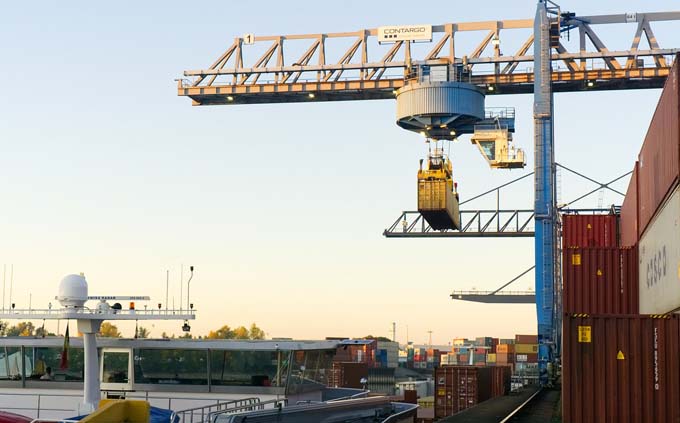Export situation between hopes and fears
Exports picked up again in the third quarter. However, the outlook for the last three months of 2020 looks bleaker again. However, the development in Germany, the most important export market for Swiss companies, gives cause for hope.

First of all, there is positive news on the Swiss export situation: According to the Export Forecast of the credit risk insurer Euler Hermes, the export index currently stands at 0.71 points. This value is above the long-term average growth rate of the Swiss export industry. Within the last three months, the forecast has increased significantly, but is still below the previous year's level, reports Euler Hermes. After the deep slump caused by the Corona pandemic in the spring, a countermovement set in from May. As the development of the forecast shows, this continued until the end of September, but tended to weaken. In October, the leading indicator then recorded a slight rebound. Provided that the trend reversal observed in October does not worsen, the Euler Hermes Export Indicator currently suggests that the export economy will grow at an above-average rate in the coming months.
Trend reversal due to poor sentiment indicators
According to Stefan Ruf, CEO Euler Hermes Switzerland, the deteriorating investor and consumer sentiment is responsible for the trend reversal in the October forecast. Rising Covid 19 infections are again weighing on consumer confidence, which is having a direct impact on the service sector. Volatility in the financial markets has also increased again. Ruf further clarifies: "The economy in Europe suffered particularly from the pandemic in the last six months. Now, with the second wave of Covid 19, there is the threat of new trouble. The Swiss export industry will also be affected. The probability of a further slide in economic development is increasing."
Decline in growth expected in fourth quarter
Following the record decline in the second quarter of 2020, Swiss foreign trade recovered significantly in the subsequent quarter. Seasonally adjusted exports rose by 6.5 percent (+9.9 percent in real terms), matching the quarterly level of three years ago in terms of sales. Imports also increased by 11.5 percent (+9.0 percent in real terms). However, after the strong economic recovery in the months of May to September, Euler Hermes expects the export situation to set back significantly again in the final quarter of 2020. Overall, the Swiss economy is expected to contract by 4.7 percent in 2020 (2021: +2.6 percent) and Swiss exports to decline by 7 percent (2021: +5.6 percent). "Even if Switzerland is still resisting a second national lockdown, another economic setback is unlikely to be avoided given heightened contagion concerns and the economy's dependence on exports," said Katharina Utermöhl, European economist at Euler Hermes. "A sustained recovery in economic momentum is not expected until the second half of 2021 - provided a vaccine against the virus can be distributed widely by then."
Export situation in Germany recovers rapidly
What applies to Switzerland can largely be applied to Germany, arguably our most important trading partner. According to the economic outlook published by Deutsche Industriebank IKB, the mood of the economy in our northern neighbor has - not surprisingly - clouded over. Even though the development of the manufacturing sector in Germany has recently proved stable, the current lockdown and above all the economic uncertainties are weighing on expectations. However, these burdens are more short-term in nature, according to IKB. Although GDP is expected to decline again in the fourth quarter of 2020, the outlook for 2021 is still considered too negative in many cases. Increasing vaccination rates and global economic growth initiated by China and other Asian countries should ensure a dynamic economic trend, especially in the second half of 2021, and increasingly replace catch-up effects as growth drivers. German industry was already able to ramp up production again quickly after the lockdown in the spring. Next year IKB expects GDP growth in Germany of around 5 %. The main drivers are likely to be less investment than exports and private consumption. These are ambivalent prospects for Swiss export companies: Depending on which sectors - consumer goods or capital goods - they operate in, things could either pick up again quickly, or the lean period will continue.
World trade indicators develop more positively than expected
Until recently, the development of world trade was encouraging. Whereas in the first half of the year the WTO was still predicting a decline in global trade volumes of more than 20 percent, a slump of less than 10 percent is currently anticipated. Freight prices have recently reached a new record high and container throughput has even exceeded the level it reached before the Corona crisis. The dynamic development of world trade is closely linked to the recovery of the raw materials markets and industry in general. For example, the J.P. Morgan global purchasing managers' index reached a new multi-year high of 53 points at the end of October. Further, most labor markets worldwide recovered in August and September, but no further improvement was observed in October.
Sources: Euler Hermes, IKB Deutsche Industriebank AG









